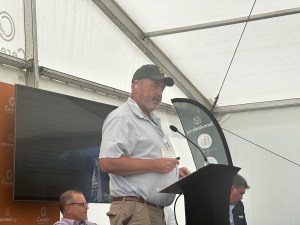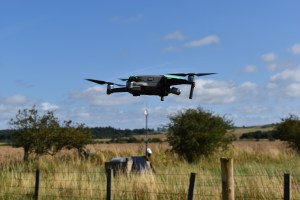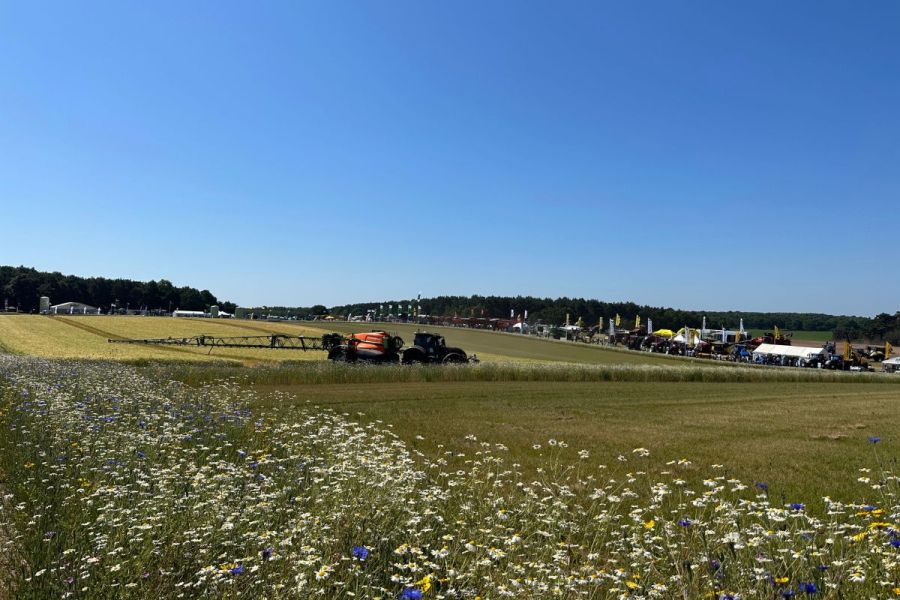Cereals is a show of many colours – it’s not just about seminars, seed breeders, ag-chem companies, or machinery manufacturers. Cereals is also about possibilities. CPM discovered what this means in terms of advancing technology and machinery.
“If we can increase yields by 10% globally, this could be a major factor in food security.”
By Melanie Jenkins
Among the raft of new and returning exhibitors at this year’s Cereals Event, many of which were hosting appealing displays of innovations and machines, the final seminar of the two-day event provided an insight into where technology in farming is headed.
Some of the technologies talked about at the event are potential game changers for the industry. One of these is genome editing (GE), a technology that underpins precision breeding, said Prof Nigel Halford of Rothamsted Research. “This is actually a suite of technologies, but CRISPR is the one that is really driving the technology forward. CRISPR involves making a genetic modification (GM) as a starting point, but this is then cut out. We can target any gene in nature which is why it’s so powerful, and it’s relatively easy to do.”
Post Brexit, the UK has been under EU legacy GM regulations, where there’s no distinction between GM and GE, he said. “This changed with the Genetic Technology Act in March which introduced the concept of a precision breeding organism. This is where the GM part has been crossed away, meaning we have a GE organism that no longer has any GM component and only then does it qualify as a precision breeding organism.”

Rothamsted Research has used CRISPR to achieve a 50% reduction in asparagine and the equivalent in acrylamide, with no effect on wheat yields, said Nigel Halford.
Now the bill has been passed in England, Rothamsted is using precision breeding to address the issues with acrylamide, which is a processing contaminant found in cooked foods, explained Nigel. “Acrylamide was discovered in 2002 and it was a big shock for the food industry because it’s carcinogenic. It affects almost all cereal-based products, fried potatoes and coffee.”
Acrylamide increases the risk of cancers, so all food businesses have to monitor its levels and take action if it passes a certain threshold, as set out by EU law, he stated. “But later this year, maximum levels will be set in EU law and it’ll be illegal to sell a product with acrylamide above these levels, however, we don’t know if the UK will follow suit.”
Wheat appears to accumulate vastly more of the amino acid asparagine in its grain than it requires to make proteins and this is what leads to acrylamide in cooked food, detailed Nigel. “But we’ve managed to use CRISPR to knock-out two of the genes responsible for this, which has resulted in a 50% reduction in asparagine and the equivalent in acrylamide, with no effect on yield or other parameters based on field trials.
“It would greatly benefit the food industry if this wheat could be used to create its products and it’s a great example of how this technology can be utilised,” he said.
From cutting out unwanted genes to increasing yields, technology is offering a multitude of solutions in agriculture. Matthew Paul of SugarOx and Rothamsted Research explained how the sugar metabolism in plants can be used to improve crop yields.
Through the understanding of how blood sugar is regulated in humans, Matthew has explored the plant equivalent. “We discovered a sugar almost 20 years ago that regulates the SnRK1 enzyme in plants and stimulates starch biosynthesis. It almost acts like a sucrose fuel gauge in plants, telling it how much sugar it has to grow and develop and how big the grains should be,” he explained.
“Because it’s a sugar, we wondered if we could modify it directly without going down the genetic approach which is quite complicated. So I teamed up with chemist Ben Davis, who designed a strategy to increase trehalose-6-phosphate (T6P) in crops. We then proposed that 10 days after anthesis would be the best time to spray these T6P compounds onto crops as that’s when grain filling begins and starch metabolism is really being activated.”

AgriSound has developed a smart listening box, which can detect the unique sounds of pollinators in an environment, said Casey Woodward.
Initial glasshouse trials in 2016 demonstrated that this could result in yield improvements of up to 20%, said Matthew. “Since then, we’ve been trying to get this working in field conditions, and trials conducted in Mexico and Argentina have been able to demonstrate increased yields of between 9-22% and 10% on average. We’ve also seen increases in both grain numbers and grain weights without dilution of protein content.”
Crops have also shown improved vascular development within the grain and better rates of photosynthesis, he said. “These results are really quite significant because if we can increase yields by 10% globally, this could be a major factor in food security. Plus it’s being done without additional fertiliser or water.”
Technology which improves productivity and efficiency isn’t just limited to plants, it’s also evident in machinery. For the past seven years, Kit Franklin has been known for his work on the Hands Free Hectare which has expanded into the Hands Free Farm (HFF). And now he’s further exploring how autonomous machines can be utilised to reduce labour, shrink the size of machinery, and improve soils while lowering inputs.
Through analysis of work on the HFF, Kit has determined that as farms get bigger, the profitability of producing wheat goes down. “But with our smaller, autonomous equipment there’s less capital expenditure, and ultimately, it’s a more efficient machine. But we’ve found that the efficiency and profitability gain from this system is actually better on smaller-sized fields,” he explained.
“But this plays into trying to increase biodiversity on farm by allowing us to reintroduce hedgerows and field trees – all the things we took out to make big machines more efficient,” he said.
Kit has also looked at multi-cropping fields, whereby there are three different crops set out in 2m rows that can all be autonomously drilled, managed and harvested using the small fleet machinery on the HFF. “This year we have wheat, barley and beans growing in alternating strips and the agronomy team at Harper Adams are monitoring these for impacts to output.
“Up until now the HFF has been focused on autonomous conventional farming methods on a small scale, but now this is being done in a novel and unique way,” said Kit. “From my point of view as an engineer, we’ve been able to get the crops into the ground successfully and to spray them. So in a few months we should be able to combine them too.”
Another technology aimed at helping improve biodiversity comes from AgriSound, in the form of microphones that can detect and monitor pollinator behaviour in field. “We’re facing challenges in the UK with pollinator numbers,” explained the firm’s Casey Woodward. “The problem is addressing this at scale. We’ve typically relied on ecologists going to fields and monitoring pollinators using sampling techniques, but there aren’t enough ecologists to do this on the scale required to deliver widespread system improvements in pollinator numbers.”
To overcome this challenge, AgriSound has developed a smart listening box, which can detect the unique sounds of pollinators in an environment, and which works 24/7, 365 days a year, he said. “It’s designed for a rural environment and so is powered by a solar panel and sends its data via a mobile phone connection, meaning it doesn’t require Wi-Fi,” he said.
“Pollinators are important for biodiversity and can help boost crop yields in a horticultural context, as well as being part of both public subsidy and private sector incentives. Using the box we can help optimise environments for pollinators by planting targeted wildflower mixes or hedgerows which attract and benefit them,” he added.

DroneAg has made it possible to measure crop cover levels, and differentiate this from weeds, resulting in a true green area index measurement using drone imagining.
From sound monitoring to aerial observation, DroneAg is on a mission to improve the efficiency of crop walking, according to founder Jack Wrangham. “We’ve built a software system that allows drones to fly very close to crops to take high resolution images which are analysed and sent to the farmer and/or agronomist about 10 minutes post flight – so the information is delivered very quickly. This is now being used on over 1000 farms in 19 countries and is providing a lot of data on where and when to treat fields.”
The ability to get so close to the ground means emerging plants can be counted, including the number of leaves, plus insect damage can be calculated, which is particularly useful with oilseed rape, he explained. “It’s also possible to indicate crop cover levels, and differentiate this from weeds, resulting in a true green area index measurement, unlike satellite imaging.
“This is then combined with satellite data to create variable rate maps. And we can also look at crop variance to determine how even or uneven a field is, which helps indicate if variable rates are required in that field.”
Flowering fraction can also be measured, which is useful for timing spray applications appropriately, he explained. “And it’s also possible to look at growth stages through to pod filling and senescence ratios, so you can understand if a field will have to be sprayed off or not and when a spray might be required.”
A further tool developed by the firm combines this ground-level data with a high-level overview of the field. But instead of drone mapping, Scout Spheres involves the drone flying above the centre of a field to capture a geolocated 360° panorama. “This provides a full overview of the field which is then quickly available via web portal anywhere in the world. This process is done completely automatically without human input in around five to 10 minutes,” he explained.
“We’re also working on base stations for drones to fly from, and we’ve just had permission from the Civil Aviation Authority (CAA) to do this on our own farm. We’ve also been working to build drone sprayer systems so all of the maps generated by the images can be exported to this as well as traditional spraying equipment.”
Further to this, the firm is working towards automated trial plot capture from 15cm above plots. “This can be done to high resolution multiple times a day to speed up and increase the efficiency of trial plots,” said Jack.
Another project involves taking soil samples with drones. “Drones are able to take 20cm core samples and can carry six samples on each flight. This is going into prototype phase, and we hope to have something to show visitors to Cereals next year,” he added.
It’s not just the software side of drone use in agriculture that is reshaping the possibilities but also the legal use of them. According to Robert Pearson of Autospray Systems, a 2022 report by PricewaterhouseCoopers found that if the government got behind UK drone adoption, it would grow the UK economy by £45bn over the next six years. This would also create 650,000 high-tech jobs and save UK businesses £22bn, all at the same time as reducing the country’s carbon output by 2.4m tonnes.
“This resulted in the government switching from being agnostic towards drones to publishing the Drone Ambition Statement, and as a result we got our licence for agricultural spraying and spreading operations in December,” explained Robert. “Since then, we’ve been applying drone technology to the agricultural industry.”
This has involved planting birch trees on slopes at risk of subsidence, applying fertiliser on hard to access grassland, and drilling crops. “What you’ll notice about all of these applications is none involve pesticides. This is because the current legalisation from the CAA says we can only apply things permitted by HSE. However, HSE and its chemical research department want the spray drift data before facilitating the wider use of pesticides from drones.”
To overcome this, the firm has worked with the Silsoe Spray Application Unit to determine droplet spray swath – the usable spray width with certain droplet sizes – analysis, and will be looking at drift next, said Robert. “Once this data has been collated, it’ll be presented to Defra and approval should follow. Drones aren’t here to replace spraying machinery, but to complement it.”
This article was taken from the latest issue of CPM. Read the article in full here.
For more articles like this, subscribe here.
Sign up for Crop Production Magazine’s FREE e-newsletter here.




